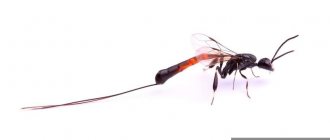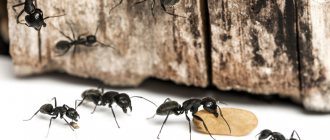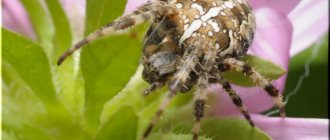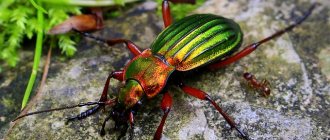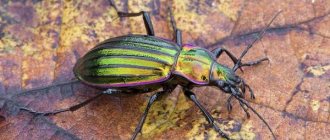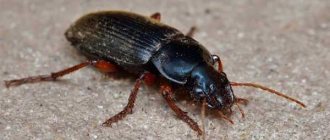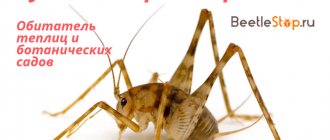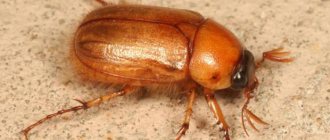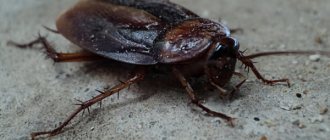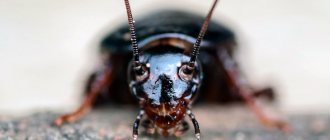Where do bugs come from in an apartment?
When the owners notice that black beetles have appeared in the room, despite the fact that there is no disorder in the room and the cleaning was carried out on time, the question immediately arises where they could come from.
Ways of appearance of beetles in an apartment:
- cracks in walls, window frames, into which small insects can easily crawl;
- ventilation shafts and openings in which protective nets are not installed;
- windows and vents, open for ventilation, can become an “entrance door” through which flying insects fly into the apartment;
- through risers of sewer and water pipes;
- black beetles appear in apartments in the summer, clinging to people’s shoes or clothes, thus penetrating the living rooms and kitchen;
- from a neighboring basement or attic.
How can you tell if there are woodworms in your house?
The appearance of woodworms that destroy wooden buildings can be identified by the following signs:
- at night, ticking and rustling sounds are heard in the walls of the house;
- upon careful examination, you can notice small passages that emit a specific sour odor;
- the appearance of winding passages on the surface of the tree;
- the appearance of fine wood dust that appears near the damaged area of the tree;
- the surface becomes porous and quickly susceptible to damage.
Let's celebrate! It is very difficult to catch woodworms; most often you come across larvae. When confronted with a person, the woodworm can pretend to be dead.
Photos and names of black beetles
You can determine exactly what the black beetle in the house is called by its appearance and size, as well as its location. They can settle both in food and in furniture, carpets or wooden structures and walls.
The most common black beetles, which sometimes settle in an apartment or private house, are beetles or flour beetles. They received their second name because they prefer to eat cereals and other bulk products.
In total, there are 3 types of Khrushchak:
- large beetles - differ in their length (up to 13 mm);
- small – have a size of up to 3.6 mm;
- black - distinguished by black color.
Black bugs in the apartment
In addition to the flour beetle, there are other types of small black bugs in the apartment:
- skin beetles - small black insects up to 4 mm in size that feed on fur and leather products, paper from books, indoor plants and food (flour, nuts, cereals, meat, etc.) - live in closets, old clothes, crevices of furniture; dangerous because they can carry infections and helminths;
- carpet beetles - they settle in beds and carpets, feeding on old peeling human skin, hair and crumbs; they can render things unusable and also cause allergies in some people;
- fleas are small jumping parasites that bite painfully and can carry infection; they often appear in homes where cats and dogs live.
Insect prevention measures
To prevent bugs from entering the house, you need to:
- Do not leave windows open without mosquito nets.
- Seal all cracks in the floor, baseboards, and near pipelines.
- Do not create large reserves of cereals and flour. Store them in a glass container with a tight-fitting lid.
- After bringing bulk products from the store, place them in the freezer for several hours.
Periodic checking of seeds, flour, and dried fruits for the presence of bugs will help to detect them in time and take measures to destroy them.
Big Khrushchak
According to the biological classification, Khrushchev beetles belong to the Darkling beetle family, numbering 11 species, of which only 3 are common in Russia and Moscow.
Khrushchak is a large black beetle up to 1.8 cm long, its body is flattened, and there are only 6 legs (3 pairs). The color of the body is black-brown and shiny, the abdomen has a reddish tint. Females lay 200 eggs. into the nest. The pest larva (popularly called a mealworm) is larger in size, up to 2.5 cm, and brownish-yellow in color. It feeds on grain, flour and bran. As the larva grows, it undergoes 4 molts.
The flour beetle chooses as habitats in the apartment those that are located near its favorite food. In nature, they prefer to live in tree hollows or rotten parts. The beetle's main diet consists of animal food (the corpses of small mammals and insects) and plant food.
Important!
When settling in an apartment, beetles look for food in the form of grain, flour, cereals or bran. They spoil food supplies, contaminating them with their excrement, skins from larvae and dead insects. In a short time, black bugs can multiply and infest all your kitchen cabinets and drawers.
Big and small Khrushchak
How to fight fleas
Fleas are incredibly jumping, mobile parasitic insects. They look for prey almost only when it is light. It is fleas that carry the most severe and dangerous diseases, but few people think about it.
This is interesting
Fleas and their hosts, rats, caused the spread of plague in the Middle Ages, as a result of which almost a third of Europe died out.
Their bites are incredibly similar to bedbug bites and can also be in the form of a chain. It is not difficult to notice fleas on light-colored underwear, but catching them is not so easy. They jump quickly, and not every person can react.
They should be destroyed in two steps: first from the spreading animal, then throughout the entire premises.
To poison fleas indoors, you need to use the same means as for bedbugs, but a veterinarian will recommend a remedy for your pet.
Small Khrushchak
The small flour beetle has a brown or red body color and causes considerable damage to the food supply of a person in an apartment. It is widespread in Russia and Ukraine, where it often causes spoilage of grain in granaries, mills and other places where bulk products are stored.
The red-brown beetle is smaller in size (up to 3.6 mm), but it loves to settle in various food supplies in the apartment: flour, nuts, dried fruits and other plant fruits.
On a note!
Unlike the large Khrushchak, the small one has wings and is able to fly. The males of such a flying insect have an abdomen rounded at the end and covered with hairs. In females, the tip of the body is bare; they are capable of laying up to 1 thousand eggs.
The larva of the small beetle has a flat shape and a length of up to 7 mm, the body color is yellow-brown (light or dark shades), the head is flattened. The body is covered with hairs and ends with 2 spines. The pupa is painted light yellow, and its body is shiny and completely naked. The development cycle of the flying black beetle is 20-120 days, and the growth rate directly depends on the amount of food and living conditions.
Black Khrushchak
The 3rd type of beetle has a darker, almost black body color, the size of which is up to 5.5 mm. Their body color is matte, the color varies from black to brown.
Unlike other species, small black beetles prefer to live only in heated rooms. By settling in the kitchens of people's houses and apartments, they are capable of ruining not only food products, but also glue, fabrics (knitwear and nylon) and other products. They are found much less frequently than their large and small counterparts. The larvae grow to a size of 12 mm.
Important!
However, once settled in an apartment, a colony of Khrushchak insects can cause a lot of harm. By feeding on the excrement of other pests (mice and rats), they can become carriers of infections and worms.
Black Khrushchak
Methods to combat bugs
If black beetles appear in the apartment, then first you should determine their type based on external signs.
Depending on the identification, you can use various control methods to help get rid of black beetles:
- Carpet beetles and carpet pests should be combated by treating carpets and furniture; first they must be wiped with a sponge soaked in a soap solution, and then with a vinegar solution; a day after treatment, carpets and furniture should be vacuumed well, and the contents of the bag should be thrown away, as there may be insect eggs in there;
- to destroy flour beetles, it is necessary to carefully sort through all reserves of bulk products (flour, cereals, sugar, etc.); if they are found, everything must be thrown away, because they are not suitable for consumption;
- inspect the contents of all cabinets for small black or red bugs, then make a solution of 1 tbsp. l. soda per 1 liter of water and treat all surfaces and shelves inside the cabinets, wash the dishes using detergents and pour boiling water over them;
- wash all surfaces in the kitchen with a solution of acetic acid or use boric acid powder, which should be rubbed into areas where parasites may live;
- treat the floor covering and baseboards with any aerosol containing an insecticide against insects (Dichlorvos, Combat, Raid, etc.);
- clothes should be boiled or washed in hot water (not lower than +60°C).
On a note!
The procedure for exterminating insects should be repeated 2 times a week for a month, since new generations of bugs will hatch from the laid eggs of insects, which also need to be destroyed.
If the measures taken do not help or there is no time to fight bugs in the apartment for a long time, then it is better to turn to professionals. There are companies that use special preparations to carry out disinfestation (extermination of pests) in any residential premises.
Fighting bugs in the house
How to get rid of parasites
You will have to start the fight against insects with a complete inspection and general cleaning:
It is necessary to carefully inspect food supplies, looking into each opened or damaged package. Products containing insects and larvae are destroyed. Closets with clothes and linen are subject to inspection. Items damaged by parasites are disposed of. If the clothes can still be worn, they are disinfected. Thoroughly wash all surfaces in the apartment: floors, shelves, furniture surfaces. Furniture and carpets are vacuumed. In places where insects “live”, surfaces are treated with the selected anti-parasite agent, both according to folk recipes and with household chemicals.
If there is a significant infestation of beetles, remove the baseboards and treat the area underneath with compounds.
Warning! Toxic chemicals designed to kill insects in the apartment pose a danger to pets and children. It is necessary to follow the instructions for use of the drug. Many products are left on for several hours after application and then washed off. After treatment with insecticides, it is necessary to ventilate the room.
Folk methods of struggle
A vinegar solution is used to treat surfaces. To prepare it, table vinegar is mixed with water at the rate of: 1 tbsp. per liter The liquid is used to wash the floor, shelves in closets and closets, and window sills. Disinfection is also carried out with a weak solution of a chlorine-containing preparation (for example, “Belizna”).
In winter, you can get rid of skin beetles by “freezing” the apartment - these beetles cannot tolerate cold. It will take several hours to cool the air temperature in the home to minus 15-20 degrees. After this, sanitary cleaning and preventive treatment of the housing are done.
The rating of the best bulk and liquid washing powders for different types of laundry can be seen in this article.
Chemicals
Household chemical stores sell products to combat household insects. To kill midges, a regular aerosol product (a poison that kills the insect instantly) is enough.
The fight against beetles and leather beetles will require more serious measures:
Poisonous solutions and powders. Concentrates are diluted in water, which is then used to wash surfaces in the home. The powders are intended for making traps with poisonous food baits. Deterrents (usually in tablets). They have a persistent odor that repels insects. They are a preventive measure.
Bark beetles and other inhabitants of wooden houses
In addition to the above beetles that settle in apartments, there are also specific species that live in a wooden house. Most often, insects enter the house along with contaminated building materials and pose a great danger to all wooden structures and furniture. They are capable of not only destroying valuable property in a short time, but also turning all the walls and structures of a building into dust.
They differ in that their main food is wood:
- bark beetles - a large group of beetles (750 species), the size of the insect is 5-10 mm, in the forest bark beetles carry out sanitary work, destroying rotten trees, and in a wooden house they are considered pests, they gnaw long passages in the wood and destroy it, insect larvae are capable of in a few years “eat” the whole house;
- grinders are long, oblong small bugs, 2-10 mm in size, black or brown in color, they are coleopteran insects, dangerous for wooden structures, furniture, books and cardboard, they also feed on grain reserves, making characteristic ticking sounds; at the slightest danger they pretend to be dead, black beetles are active in the house at night and can only be identified by rustling and other sounds;
- longhorned beetles are larger pests (up to 35 mm in size) of black, brown or blue-green color, with large mustaches (10 times longer than the body), the larvae are large, up to 3 cm in size, capable of damaging a wooden frame in a private house, transforming structures to complete ruin in a relatively short period of time, they prefer to settle in coniferous wood (in partitions, floors, on the roof, etc.).
Bark beetles
Interesting!
All beetles that chew on wooden walls or furniture in the house make a characteristic sound, similar to the ticking of a mechanical watch. In the old days, such parasites were called “death clocks”, due to the fact that their activity often led to the collapse of wooden houses and the death of their inhabitants.
The development of beetles that feed on wood follows the same pattern. Females lay eggs in crevices, from which larvae hatch and gnaw into wood walls. They gnaw passages in it and spoil the appearance and structure of wooden walls and ceilings. After the larvae transform into pupae, adults crawl to the surface.
What to do if insects don't go away
If carpet beetles remain a problem in your home, there are other great ways to get rid of these insects without calling a pest control professional or using pesticides. Below are the main methods.
Use peppermint oil
Are mosquitoes, ants or even spiders a nuisance in your home? Not only will peppermint get rid of such insects, but it will also make your home smell nice with its sweet aroma. Add eight drops of natural peppermint oil to a glass of water, pour into a spray bottle, shake, and then spray around vents, doorways and windows.
Use diatomaceous earth
Diatomaceous earth is made from single-celled algae that have been fossilized and ground up. If your home has been invaded by stink bugs, flies, bed bugs, beetles and spiders; Diatomaceous earth will help you. It is not harmful to humans, but is lethal to small, black, hard-shelled beetles inside the home. It only takes 48 hours after this black carpet beetle's exoskeleton comes into contact with it for the insects to dehydrate and die.
